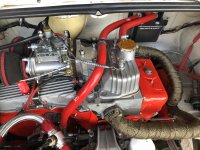Greetings All, I've been giving my car some hard driving of late and due to the use of a Solex twin choke I don't have a crankcase vent recirculation system feeding into the air intake. I was somewhat perplexed when I noticed that my oil catch can was showing a higher level of oil after my last run as the car has not given such an indication before (hard driving?) So I burned the midnight oil and researched for any possible causes. After consulting with my engine man I have arrived at the following conclusion - It seems that my crankcase is becoming pressurised at high rpm (6000+) As the engine has run-in there may be some blow by occurring too, now I'm not concerned with this as All engines suffer blow-by to some extent and as mine is running 10.5:1 compression ratio it's a given that it will happen. 

 and both of the pistons plunging down together will increase the effect. I have tested the plugs and found them with good colour and no contamination, the exhaust gas has no oil smoke, so I'm happy that the oil is only being fed to the catch can at high rpm. I've consulted some literature from 'Burton Power' that covers this area and have decided that if I'm going to continue running the car as I have I will need a better oil recovery system, and as I'm not one to vent any oil vapour through a tube onto the road
and both of the pistons plunging down together will increase the effect. I have tested the plugs and found them with good colour and no contamination, the exhaust gas has no oil smoke, so I'm happy that the oil is only being fed to the catch can at high rpm. I've consulted some literature from 'Burton Power' that covers this area and have decided that if I'm going to continue running the car as I have I will need a better oil recovery system, and as I'm not one to vent any oil vapour through a tube onto the road
it will have to be of sufficient size to stop frequent can emptying procedures

 My original can was only 400ml and noting that this seems to be insufficient I went straight to 1Ltr
My original can was only 400ml and noting that this seems to be insufficient I went straight to 1Ltr 

The literature recommended venting the crankcase too so I've fashioned a simple take off that fits onto the fuel pump mount and fed silicone piping from it and the rocker box vent to the can on the bulkhead, now all I need is the time and weather for an extended road test - more later


Pics show before and after.
Ian.
it will have to be of sufficient size to stop frequent can emptying procedures
The literature recommended venting the crankcase too so I've fashioned a simple take off that fits onto the fuel pump mount and fed silicone piping from it and the rocker box vent to the can on the bulkhead, now all I need is the time and weather for an extended road test - more later
Pics show before and after.
Ian.




